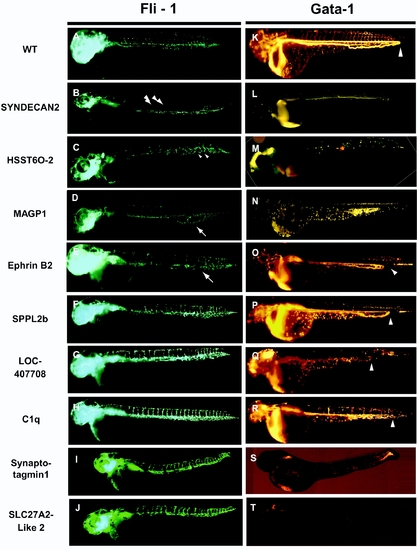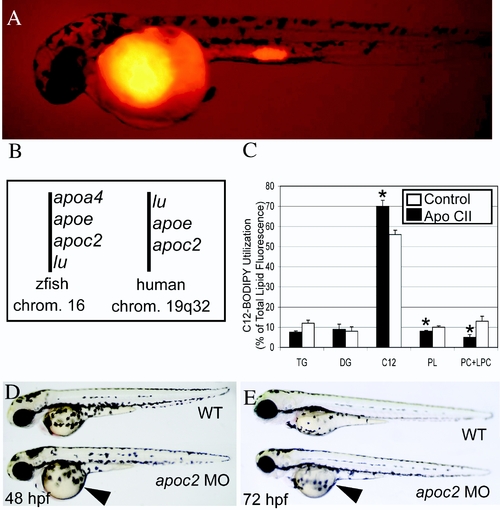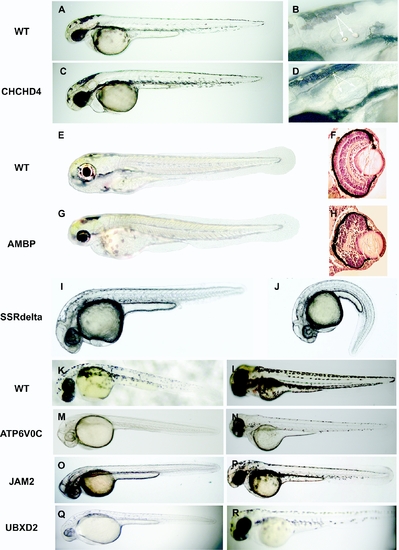- Title
-
Genome-wide reverse genetics framework to identify novel functions of the vertebrate secretome
- Authors
- Pickart, M.A., Klee, E.W., Nielsen, A.L., Sivasubbu, S., Mendenhall, E.M., Bill B.R., Chen, E., Eckfeldt, C.E., Knowlton, M., Robu, M.E., Larson, J.D., Deng, Y., Schimmenti, L.A., Ellis, L.B., Verfaillie, C.M., Hammerschmidt, M., Farber, S.A., and Ekker, S.C.
- Source
- Full text @ PLoS One
|
Defects in vasculogenesis and hematopoeisis observed in Tg (fli-1:eGFP (green)) or Tg (gata-1:DsRed (red)) embryos following MO inactivation of select CTT genes. (A) Normal vascular development observed in untreated Tg (fli-1:eGFP) embryos. (B, L) Decreases in the number of vascular sprouts (arrow heads) observed following injection of MO targeting Syndecan-2[20]. (C, M) Gaps within the caudal vein plexus (small arrow heads) observed following injection of MO targeting heparin sulfatetransferase-6-O 2-sulfotransferase (HSST6O-2)[21]. (D, N) Loss of integrity in the caudal vein plexus (arrow) observed following injection of MO targeting MAGP1[22]. Premature return in caudal vein flow shown by gata-1:dsRed expression to varying severities (arrowheads) following injection of MOs targeting Ephrin B2 (E,O), SPPL2b (F,P), predicted protein LOC407708 (G, Q), and C1q (H, R). Note: the premature return defects were not shown by fli-1:eGFP expression (E, F, G, H), however, were confirmed by other vascular markers (data not shown). (K) Normal blood development observed in untreated Tg (gata-1:DsRed) embryos. Decreased number of blood cells observed in 2 dpf embryos following injection with MO against Synaptotagmin13 (S) or Novel Protein similar to SLC27A2 (T). Accompanying panels (I) and (J) display no major vasculature defects for each of these genes respectively. |
|
ApoC2 is required for yolk lipid procesing. Embryos at the 1–8 cell stage were initially injected with a MO of interest. At 24 hpf, a fluorescent fatty acid (BODIPY-C12) was injected into the yolk. (A) 48 hpf embryo injected with BODIPY-C12 at 24 hpf. Embryos were then kept in the dark until 72 hpf when they were scored for morphologic phenotype. Embryos (4/tube) were homogenized in 50% methanol and extracted TLC plates were then scanned to reveal triacylglycerol (TG), diacylglycerol (DG), initial substrate (C12) and phospholipids (phosphatidylcholine (PC) and lysophosphatidylcholine (LPC)). Fluorescent intensities were quantified and the total fluorescence of all lipids was determined. (B) For each MO injected, data were expressed as a percent of total lipids and compared to a phenol red control to obtain the percent of control (C) A second experiment comparing BODIPY-C12 incorporation in control and Apo2c MO injected embryos. A given experiment represents a mean of at least three individual lipid extracts with 4 embryos each. * p<0.05 (D) Syntenic analysis indicates that the zebrafish EST sequence with homology to Apoc2, is the fish ortholog of that gene. (E,F) Morphology of embryos injected with apoC2 MO. Arrowheads indicate enlarged yolk. PHENOTYPE:
|
|
Morphological defects observed following MO inactivation of select CTT genes. (A, B) Otolith morphology observed in 2 dpf untreated embryos. (C, D) Absence of otoliths, in otherwise normal 2 dpf embryo, following injection of MO targeting CHCHD4. (B, D) Enlarged view of otic capsules; arrows denote normally formed (B) or absent (D) otoliths, respectively. (E, F) Eye morphology in 3 dpf embryos. (G, H) Abnormally small eyes observed in 3 dpf embryo following injection of MO targeting AMBP. (F, H) Enlarged view of histological sections of eye in un-affected (F) and affected (H) embryos. Note differences in both the size and tissue organization of the affected eye. (I) Wild-type morphology of 1 dpf embryo. (J) Ventral curvature phenotype observed in 1 dpf embryos injected with MO targeting SSRdelta. (K, L) Normal pigmentation observed in untreated 1 and 2 dpf embryos. Reduction in pigment observed in 1 and 2 dpf embryos, respectively, following injection of MO targeting ATP6V0C (M, N)[23], or junction adhesion molecule 2 (JAM2) (O, P), or UBX domain containing 2 (UBXD2) (Q, R)). PHENOTYPE:
|

Unillustrated author statements |



